Related Research Articles

The Canterbury Tales is a collection of twenty-four stories that runs to over 17,000 lines written in Middle English by Geoffrey Chaucer between 1387 and 1400. It is widely regarded as Chaucer's magnum opus. The tales are presented as part of a story-telling contest by a group of pilgrims as they travel together from London to Canterbury to visit the shrine of Saint Thomas Becket at Canterbury Cathedral. The prize for this contest is a free meal at the Tabard Inn at Southwark on their return.
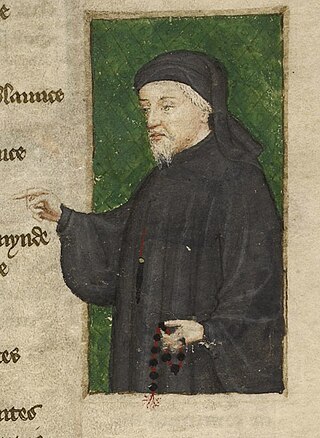
Geoffrey Chaucer was an English poet, author, and civil servant best known for The Canterbury Tales. He has been called the "father of English literature", or, alternatively, the "father of English poetry". He was the first writer to be buried in what has since come to be called Poets' Corner, in Westminster Abbey. Chaucer also gained fame as a philosopher and astronomer, composing the scientific A Treatise on the Astrolabe for his 10-year-old son Lewis. He maintained a career in the civil service as a bureaucrat, courtier, diplomat, and member of parliament.
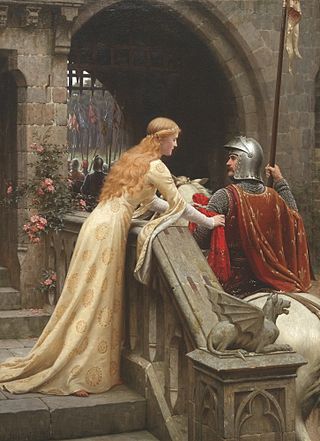
Courtly love was a medieval European literary conception of love that emphasized nobility and chivalry. Medieval literature is filled with examples of knights setting out on adventures and performing various deeds or services for ladies because of their "courtly love". This kind of love was originally a literary fiction created for the entertainment of the nobility, but as time passed, these ideas about love spread to popular culture and attracted a larger literate audience. In the high Middle Ages, a "game of love" developed around these ideas as a set of social practices. "Loving nobly" was considered to be an enriching and improving practice.

John Gower was an English poet, a contemporary of William Langland and the Pearl Poet, and a personal friend of Geoffrey Chaucer. He is remembered primarily for three major works—the Mirour de l'Omme, Vox Clamantis, and Confessio Amantis—three long poems written in French, Latin, and English respectively, which are united by common moral and political themes.
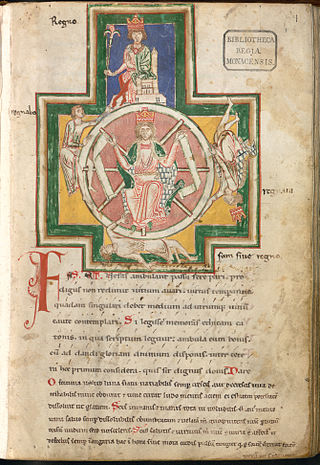
The goliards were a group of generally young clergy in Europe who wrote satirical Latin poetry in the 12th and 13th centuries of the Middle Ages. They were chiefly clerics who served at or had studied at the universities of France, Germany, Spain, Italy, and England, who protested against the growing contradictions within the church through song, poetry and performance. Disaffected and not called to the religious life, they often presented such protests within a structured setting associated with carnival, such as the Feast of Fools, or church liturgy.

The estates of the realm, or three estates, were the broad orders of social hierarchy used in Christendom from the Middle Ages to early modern Europe. Different systems for dividing society members into estates developed and evolved over time.
A fabliau is a comic, often anonymous tale written by jongleurs in northeast France between c. 1150 and 1400. They are generally characterized by sexual and scatological obscenity, and by a set of contrary attitudes—contrary to the church and to the nobility. Several of them were reworked by Giovanni Boccaccio for the Decameron and by Geoffrey Chaucer for his Canterbury Tales. Some 150 French fabliaux are extant, the number depending on how narrowly fabliau is defined. According to R. Howard Bloch, fabliaux are the first expression of literary realism in Europe.

Troilus and Criseyde is an epic poem by Geoffrey Chaucer which re-tells in Middle English the tragic story of the lovers Troilus and Criseyde set against a backdrop of war during the siege of Troy. It was written in rime royale and probably completed during the mid-1380s. Many Chaucer scholars regard it as the poet's finest work. As a finished long poem, it is more self-contained than the better known but ultimately unfinished The Canterbury Tales. This poem is often considered the source of the phrase: "all good things must come to an end" (3.615).

The General Prologue is the first part of The Canterbury Tales by Geoffrey Chaucer. It introduces the frame story, in which a group of pilgrims travelling to the shrine of Thomas Becket in Canterbury agree to take part in a storytelling competition, and describes the pilgrims themselves. The Prologue is arguably the most familiar section of The Canterbury Tales, depicting traffic between places, languages and cultures as well as introducing and describing the pilgrims who will narrate the tales.
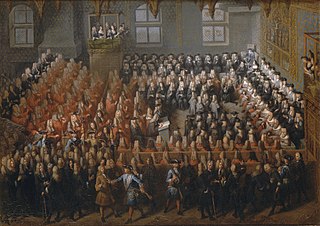
The Parlement of Paris was the oldest parlement in the Kingdom of France, formed in the 14th century. It was fixed in Paris by Philip IV of France in 1302. The Parlement of Paris would hold sessions inside the medieval royal palace on the Île de la Cité, nowadays still the site of the Paris Hall of Justice.
The term Middle English literature refers to the literature written in the form of the English language known as Middle English, from the late 12th century until the 1470s. During this time the Chancery Standard, a form of London-based English, became widespread and the printing press regularized the language. Between the 1470s and the middle of the following century there was a transition to early Modern English. In literary terms, the characteristics of the literary works written did not change radically until the effects of the Renaissance and Reformed Christianity became more apparent in the reign of King Henry VIII. There are three main categories of Middle English literature, religious, courtly love, and Arthurian, though much of Geoffrey Chaucer's work stands outside these. Among the many religious works are those in the Katherine Group and the writings of Julian of Norwich and Richard Rolle.
Middle English lyric a genre of English literature, is characterized by its brevity and emotional expression. Conventionally, the lyric expresses "a moment," usually spoken or performed in the first person. Although some lyrics have narratives, the plots are usually simple to emphasize an occasional, common experience. Even though lyrics appear individual and personal, they are not "original"; instead, lyrics express a common state of mind. Those states of mind are wide in range. Some deal with religious topics pertaining to Jesus or the Virgin Mary, focusing on Christ's sacrifice and salvation, or Mary's roles as a mother and intercessor. Other religious topics focus on Adam and the Fall, or the necessity of faith. Others are secular, focusing on ale, women, and the simple joys of life. Some are sarcastic, satiric, humorous, or even crude.
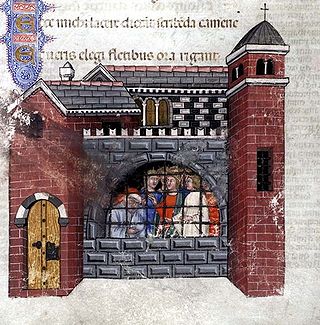
A dream vision or visio is a literary device in which a dream or vision is recounted as having revealed knowledge or a truth that is not available to the dreamer or visionary in a normal waking state. While dreams occur frequently throughout the history of literature, visionary literature as a genre began to flourish suddenly, and is especially characteristic in early medieval Europe. In both its ancient and medieval form, the dream vision is often felt to be of divine origin. The genre reemerged in the era of Romanticism, when dreams were regarded as creative gateways to imaginative possibilities beyond rational calculation.

Confessio Amantis is a 33,000-line Middle English poem by John Gower, which uses the confession made by an ageing lover to the chaplain of Venus as a frame story for a collection of shorter narrative poems. According to its prologue, it was composed at the request of Richard II. It stands with the works of Chaucer, Langland, and the Pearl poet as one of the great works of late 14th-century English literature. The Index of Middle English Verse shows that in the era before the printing press it was one of the most-often copied manuscripts along with Canterbury Tales and Piers Plowman.
The Nobles of the Sword were the noblemen of the oldest class of nobility in France dating from the Middle Ages and the early modern period, and arguably still in existence by descent. It was originally the knightly class, owing military service in return for the possession of feudal landed estates. They played an important part during the French Revolution since their attempts to retain their old power monopoly caused the new nobility’s interests to align with the newly arising French bourgeoisie class, creating a powerful force for change in French society in the late 18th century. For the year 1789, Gordon Wright gives a figure of 80,000 nobles.

The Cahiers de doléances were the lists of grievances drawn up by each of the three Estates in France, between January and April 1789, the year in which the French Revolution began. Their compilation was ordered by Louis XVI, who had convened the Estates General of 1789 to manage the revolutionary situation, to give each of the Estates – the First Estate, the Second Estate and the Third Estate, which consisted of everyone else, including the urban working class, the rural peasantry, and middle class and professional people, who were the only ones in the group likely to have their voices heard – the chance to express their hopes and grievances directly to the King. They were explicitly discussed at a special meeting of the Estates-General held on 5 May 1789. Many of these lists have survived and provide considerable information about the state of the country on the eve of the revolution. The documents recorded criticisms of government waste, indirect taxes, church taxes and corruption, and the hunting rights of the aristocracy.

Gentry are "well-born, genteel and well-bred people" of high social class, especially in the past. Gentry, in its widest connotation, refers to people of good social position connected to landed estates, upper levels of the clergy, or "gentle" families of long descent who in some cases never obtained the official right to bear a coat of arms. The gentry largely consisted of landowners who could live entirely from rental income or at least had a country estate; some were gentleman farmers. In the United Kingdom, the term gentry refers to the landed gentry: the majority of the land-owning social class who typically had a coat of arms but did not have a peerage. The adjective "patrician" describes in comparison other analogous traditional social elite strata based in cities, such as the free cities of Italy and the free imperial cities of Germany, Switzerland, and the Hanseatic League.

Gillian Lesley "Jill" Mann, FBA, is a scholar known for her work on medieval literature, especially on Middle English and Medieval Latin.
Sebastian Sobecki is a medievalist specialising in English literature, history, and manuscript studies.
Christopher Cannon is a medievalist at Johns Hopkins University. He is currently Bloomberg Distinguished Professor of English and Classics, previously Chair of Classics, and from 2020-2024 Vice Dean for the Humanities and Social Sciences in the Krieger School of Arts and Sciences. His research and writings have focused on the works of Geoffrey Chaucer, early Middle English, and elementary learning in the Middle Ages.
References
- ↑ Mann, Jill. Chaucer and Medieval Estates Satire. Cambridge: Cambridge University Press, 1973, p. 123.
- ↑ "Estates Satire". The Norton Anthology of English Literature. W.W. Norton & Company. Archived from the original on 25 March 2015. Retrieved 25 March 2015.
- ↑ Mann, Chaucer and Medieval Estates Satire.
- "Estates Satire". The Norton Anthology of English Literature. W.W. Norton & Company. Retrieved 25 March 2015.
- Mann, Jill. Chaucer and Medieval Estates Satire. Cambridge: Cambridge University Press, 1973.
- Schwartz, Debora. "The Three Estates". CPSU. Archived from the original on 2012-08-20.
- George W. Tuma; Dinah Hazell, eds. (2008). "THE WICKED AGE: MIDDLE ENGLISH COMPLAINT LITERATURE IN TRANSLATION". Medieval Forum.